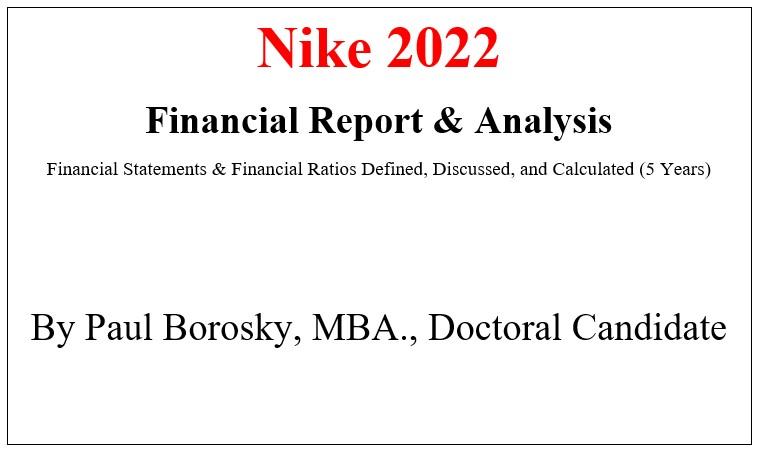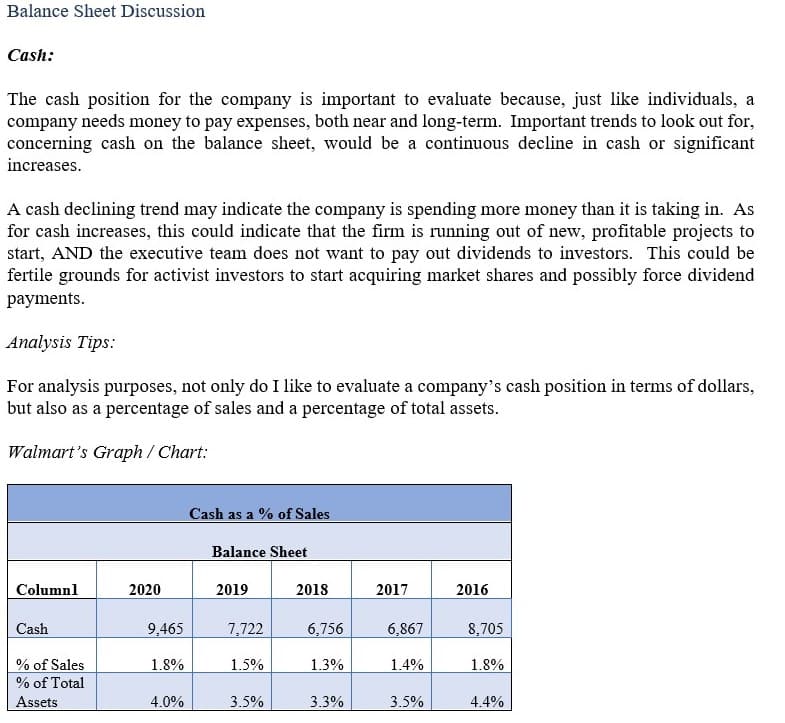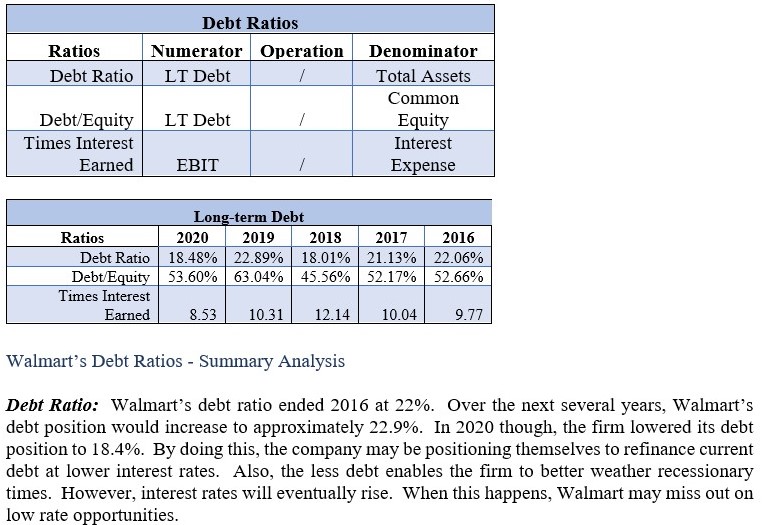Nike Financial Analysis and Financial Ratios
Quality Business Consultant's financial analysis expert, Paul Borosky, MBA., doctoral candidate, and published author, has created proprietary financial models to help analyze Nike's financial performance using Nike's summarized income statements and balance sheets for the last five years, 2016 to 2020, found in their Annual Reports and Nike's 10ks.
Further, our financial model also calculates over 20 popular financial ratios, such as Nike's current ratio, return on equity, and debt ratio. This information is the basis of our financial report, "Nike's Financial Report," where we offer insights into understanding Nike's financial standing through insightful financial analysis.
A Beginner's Guide to Nike Financial Analysis - 2022
- Included Easy to download PDF File.
- Included Easy to use format.
- Included Summarized Income Statements and Balance Sheets for the last 5 years..
- Included Popular financial ratios for the last 5 years included... with calculations and formulas!
- Included Expert tips to help with financial statements analysis.
- Included Expert tips to help with financial ratios analysis.
- NOT Included-Identify and discuss financial trends for the company..
- NOT Included-Expert financial analysis done by Paul Borosky, MBA.
- NOT Included- Analyst "Letter Grades" for the company's ratios.
Nike Financial Report by Paul Borosky, MBA. - 2022
- Included Easy to download PDF File.
- Included Easy to use format.
- Included Summarized Income Statements and Balance Sheets for the last 5 years..
- Included Popular financial ratios for the last 5 years included... with calculations and formulas!
- Included Expert tips to help with financial statements analysis.
- Included Expert tips to help with financial ratios analysis.
- Included Identify and discuss financial trends for the company.
- Included Expert financial analysis done by Paul Borosky MBA.
- Included Analyst "Letter Grades" for the company's ratios.
Nike's Financial Report and Annual Report

Click Below for the CURRENT
Downloadable PDF Price!!
Nike Beginner’s Guide 2022
Table of Contents
- Disclaimer 3
- Forward 4
- Income Statement 6
- Nike’s Summarized Income Statements 6
- Revenues 7
- Cost of Goods Sold (COGS) 8
- Selling, General, and Administrative Expenses (SG&A 8
- Research and Development (R&D) 9
- Operating Expenses 10
- Earnings Before Interest and Taxes (EBIT 10
- Interest Expense 11
- Earnings Before Taxes (EBT) 12
- Taxes 12
- Net income 12
- Tax Rate 13
- Balance Sheet 15
- Nike’s Summarized Balance Sheets 15
- Cash 16
- Short-Term Investments 17
- Accounts Receivables 17
- Inventory 18
- Current Assets 19
- Property, Plant, and Equipment (PP&E) 20
- Total Assets 20
- Accounts Payable 21
- Accrued Expenses 22
- Short-Term Debt 23
- Total Current Liabilities 24
- Long Term Debt (LT Debt) 25
- Total Liabilities 26
- Common Stock and Additional Paid-in Capital 27
- Treasury 27
- Retained Earnings 28
- Total Equity 29
- Financial Ratios 30
- Nike’s Liquidity Ratios 31
- Current Ratio 31
- Quick Ratio 32
- Cash Ratio 33
- Nike’s Asset Ratios 35
- Total Asset Turnover 36
- Fixed Asset Turnover 37
- Days Sales Outstanding 37
- Inventory Turnover 38
- Accounts Receivable Turnover 39
- Accounts Payable Turnover 40
- Other Asset Ratio Calculations 41
- Working Capital Turnover 41
- Average Days in Inventory 41
- Average Days Payable 41
- Nike’s Profitability Ratios 43
- Return on Assets (ROA) 43
- Return on Equity (ROE) 44
- Net Profit Margin 45
- Gross Profit Margin 46
- Operating Profit Margin 46
- Nike’s Debt Ratios 48
- Debt Ratio 48
- Debt to Equity Ratio 49
- Times Interest Earned 50

Click Below for the CURRENT
Downloadable PDF Price!!
Nike Financial Report 2022
Contents
- Disclaimer 3
- Forward 4
- Income Statement 6
- Nike’s Summarized Income Statements 6
- Revenues 7
- Cost of Goods Sold (COGS) 8
- Selling, General, and Administrative Expenses (SG&A 9
- Research and Development (R&D) 10
- Operating Expenses 11
- Earnings Before Interest and Taxes (EBIT 11
- Interest Expense 12
- Earnings Before Taxes (EBT) 13
- Taxes 13
- Net income 14
- Tax Rate 15
- Balance Sheet 16
- Nike’s Summarized Balance Sheets 16
- Cash 17
- Short-Term Investments 18
- Accounts Receivables 19
- Inventory 20
- Current Assets 20
- Property, Plant, and Equipment (PP&E) 21
- Total Assets 22
- Accounts Payable 23
- Accrued Expenses 24
- Short-Term Debt 25
- Total Current Liabilities 26
- Long Term Debt (LT Debt) 27
- Total Liabilities 28
- Common Stock and Additional Paid-in Capital 29
- Treasury 30
- Retained Earnings 31
- Total Equity 31
- Financial Ratios 33
- Nike’s Liquidity Ratios 34
- Current Ratio 34
- Cash Ratio 35
- Quick Ratio 36
- Nike’s Asset Ratios 38
- Total Asset Turnover 39
- Fixed Asset Turnover 40
- Days Sales Outstanding 41
- Inventory Turnover 42
- Accounts Receivable Turnover 43
- Accounts Payable Turnover 44
- Other Asset Ratio Calculations 44
- Working Capital Turnover 44
- Average Days in Inventory 45
- Average Days Payable 45
- Nike’s Profitability Ratios 46
- Return on Assets (ROA) 46
- Return on Equity (ROE) 47
- Net Profit Margin 48
- Gross Profit Margin 49
- Operating Profit Margin 50
- Nike’s Debt Ratios 52
- Debt Ratio 52
- Debt to Equity Ratio 53
- Times Interest Earned 54
- Summary 56
- Nike’s Strengths 56
- Nike’s Weaknesses 56
- Nike’s Final Grade 56
Nike Financial Report by Paul Borosky, MBA.
Hey All,
Thanks for considering my Nike Financial Report. In this report, you will be able to find preliminary information about Apple's current financial performance as well as some historical track records and trends. Also, in this report, written by myself, Paul Borosky, MBA., Doctoral Candidate and published author, you will find:
- Summarized income statement for the last 5 years.
- Summarized balance sheet for the last 5 years.
- Summary analysis by myself of the important income statement, balance sheet, and financial ratio trends and other happenings.
- Five years’ worth of over twenty common financial ratios presented with formulas, calculations, and analysis tips for each ratio.
- Line by line description, explanation, and analysis tip for most financial statement line items and financial ratios.
- Professional financial analysis tips are provided in each section to help YOU conduct your OWN financial analysis!
- Each section includes an “in other words” segment. This is where I use plain English to explain concepts.
Sincerely,
Paul, MBA.
Sample Report


Nike Income Statement Analysis Sample
In this section of the financial report, I walk you through a broad definition as to what an income statement is and why it is important. From this, I then discuss and define important income statement line items, such as revenues, gross profits, etc. in detail. Finally, I offer a summary analysis of the company's important income statement line item trends. For example,...
Nike Cost of Goods Sold.
Nike's cost of goods sold (COGS) in 2018 was $20.4 billion, or 56.2% of revenues. In 2022, their COGS were $25.2 billion, or 54% of revenues. This trend indicates that the organization may have been able to increase prices while maintaining the cost of goods sold. This is an excellent trend from an investor's perspective.
Analyst Grade: A
Nike 2022 Summary Income Statement |
|||||
| Column1 |
2022 |
2021 | 2020 | 2019 |
2018 |
| Revenues |
46,710 |
44,538 | 37,403 | 39,117 |
36,397 |
| COGS |
25,231 |
24,576 | 21,162 | 21,643 |
20,441 |
| Gross Profit |
21,479 |
19,962 | 16,241 | 17,474 |
15,956 |
| SG&A |
14,804 |
13,025 | 13,126 | 12,702 |
11,511 |
| Depreciation |
717 |
744 | 721 | 705 |
747 |
| R & D | - | - | - | ||
| Other | - | - | - | ||
| Total Operating Expenses |
15,521 |
13,769 | 13,847 | 13,407 |
12,258 |
| EBIT |
6,923 |
2,976 | 4,850 |
4,379 |
|
| Other Income | - | - | |||
| Interest Expense |
205 |
262 | 89 | 49 |
54 |
| EBT |
15,316 |
6,661 | 2,887 | 4,801 |
4,325 |
| Taxes |
605 |
934 | 348 | 772 |
2,392 |
| Net Income |
6,046 |
5,727 | 2,539 | 4,029 |
1,933 |
Nike Balance Sheet Analysis Sample
In this section of the financial report, I walk you through a broad definition as to what a balance sheet is and why it is important. From this, I then discuss and define important balance sheet line items, such as cash, inventory, etc. in detail. Finally, I offer a summary analysis of the company's important balance sheet line item trends. For example,...
Nike Property, Plant, and Equipment
Nike's property, plant, and equipment (PP&E) in 2018 were $4.4 billion or 36.3% of sales. In 2022, their PP&E was $4.7 billion or 30.9% of sales. This trend indicates the organization is generating sales at a faster pace as compared to their property, plant, and equipment growth. In other words, the organization is continually increasing the utilization of its fixed assets. This is an excellent trend from an investor's perspective.
Analyst Grade: A
Nike 2022 Summary Balance Sheet |
|||||
| Column1 |
2022 |
2021 | 2020 | 2019 |
2018 |
| Cash |
8,574 |
9,889 | 8,348 | 4,466 |
4,249 |
| Short Term Investment |
4,423 |
3,587 | 439 | 197 |
996 |
| Account Receivable |
4,667 |
4,463 | 2,749 | 4,272 |
3,498 |
| Inventory |
8,420 |
6,854 | 7,367 | 5,622 |
5,261 |
| Other | - | - | - | - | |
| Current Assets |
28,213 |
26,291 | 20,556 | 16,525 |
15,134 |
| Net PPE |
2,926 |
4,904 | 4,866 | 4,744 |
4,454 |
| Goodwill |
284 |
242 | 223 | 154 |
154 |
| Other | - | - | - | - | - |
| Total Assets |
40,321 |
37,740 | 31,342 | 23,717 |
22,536 |
| Accounts Payable |
3,358 |
2,836 | 2,248 | 2,612 |
2,279 |
| Accrued Expense |
6,220 |
6,063 | 5,184 | 5,010 |
3,269 |
| Accrued Taxes |
222 |
306 | 156 | 229 |
150 |
| Notes Payable |
10 |
2 | 248 | 9 |
336 |
| LT Debt - Current |
500 |
- | 3 | 6 |
6 |
| Other | - | - | - | - | - |
| Total Current Liabilities |
10,730 |
9,674 | 8,284 | 7,866 |
6,040 |
| LT Debt |
8,920 |
9,413 | 9,406 | 3,464 |
3,468 |
| Other | - | - | - | - | - |
| Total Liabilities |
25,040 |
24,973 | 23,287 | 14,677 |
12,724 |
| Common Stock |
11,487 |
9,968 | 8,302 | 7,163 |
6,384 |
| Treasury | - | - | - | - | - |
| Retained Earnings |
3,476 |
3,179 | (191) | 1,643 |
3,517 |
| Other | - | - | - | - | - |
| Total Equity |
15,281 |
12,767 | 8,055 | 9,040 |
9,812 |
| Total Equity & Liability |
40,321 |
37,740 | 31,342 | 23,717 |
22,536 |
Nike Financial Ratios Sample
In this section of the financial report, I walk you through definitions of various popular financial ratios, how to calculate the ratios, formulas used, etc. Also, for some popular financial ratios, I provide brief explanations of what the ratios mean as it is related to the company.
Nike's Fixed Asset Turnover Ratio
Nike's fixed asset turnover in 2020 was 7.6. In 2022, their fixed asset turnover was 9.7. This trend indicates the organization has taken steps to improve its utilization of its fixed assets under management. From an investor's perspective, this is a good trend.
Analyst Grade: A
Nike's Return on Equity
Nike's return on equity (ROE) in 2021 was 44.8%. In 2022, their ROE was 39.5%. This trend indicates the organization generated fewer revenues from equity supplied to the company. From an investor's perspective, this trend should be concerning.
Analyst Grade: B
Nike 2022 Liquidity Ratios |
|||||
| Ratios |
2022 |
2021 | 2020 | 2019 |
2018 |
| Current Ratio |
2.63 |
2.72 |
|||
| Cash Ratio |
1.21 |
1.39 |
|||
| Quick Ratio |
1.84 |
2.01 |
|||
| Net Working Capital |
17,483 |
16,617 |
|||
Nike 2022 Asset Utilization |
|||||
| Ratios |
2022 |
2021 | 2020 | 2019 |
2018 |
| Total Asset Turnover |
1.16 |
1.18 |
|||
| Fixed Asset Turnover |
15.96 |
9.08 |
|||
| Days Sales Outstanding |
35.67 |
29.55 |
|||
| Inventory Turnover (Using Sales) |
6.12 |
6.26 |
|||
| Inventory Turnover (Using COGS) |
3.30 |
3.46 |
|||
| Accounts Receivable Turnover |
10.23 |
12.35 |
|||
| Working Capital Turnover |
2.67 |
2.68 |
|||
| AP Turnover |
8.65 |
9.47 |
|||
| Average Days Inventory |
110.48 |
105.60 |
|||
| Average Days Payable |
42.18 |
38.56 |
|||
Nike 2022 Profitability Ratios |
|||||
| Ratios |
2022 |
2021 | 2020 | 2019 |
2018 |
| Return on Assets |
14.99% |
15.17% |
|||
| Return on Equity |
39.57% |
44.86% |
|||
| Net Profit Margin |
12.94% |
12.86% |
|||
| Gross Profit Margin |
45.98% |
44.82% |
|||
| Operating Profit Margin |
0.00% |
15.54% |
|||
| Basic Earning Power |
0.00% |
18.34% |
|||
| ROCE |
0.00% |
24.67% |
|||
| Capital Employed |
29,591 |
28,066 |
|||
| ROIC |
0.00% |
26.83% |
|||
Nike 2022 Debt Ratios |
|||||
| Ratios |
2022 |
2021 | 2020 | 2019 |
2018 |
| Debt Ratio |
23.39% |
24.95% |
|||
| Debt/Equity |
61.71% |
73.74% |
|||
| Times Interest Earned | - |
26.42 |
|||